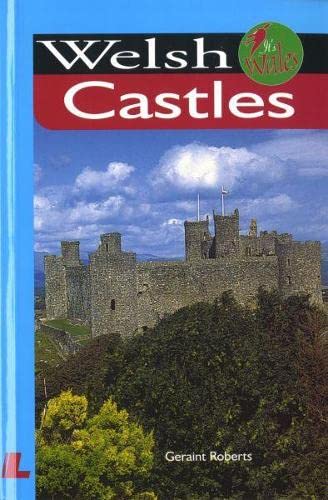
Book - It's Wales: Welsh Castles - Paperback
/
ISBN: 9780862435509 (0862435501)
Publication Date: 01 March 2006
Publisher: Y Lolfa
Format: Paperback, 185x120 mm, 72 pages
Language: English
An interesting introduction to twenty Welsh castles, comprising short notes on their history and the people connected with them. 18 black-and-white photographs. Reprint; first published in 2001.
A review from www.gwales.com, with the permission of the Welsh Books Council:-
Ever since the celebration of the 'Year of the Castles' back in 1983, there has been a spiralling interest in the extensive castle heritage of Wales. In this slim volume, characteristically well produced by Gwasg y Lolfa as volume 8 of its It's Wales series, Geraint Roberts has produced a useful, attractive, readable brief survey.
In his introduction, the author tells us modestly that the volume is 'not a guidebook that meticulously details the entire course of a castle's history'. Rather, it is 'an attempt to tell some of the stories that are to be found in the past of many of Wales's castles'. To accomplish the task, he has assembled much digestible material on twenty of Wales's most famous castles. His choice is generally unobjectionable, but one might possibly carp at the omission of castles such as Aberystwyth, Castell y Bere, Conwy, Cricieth and Dinefwr. No doubt Mr Roberts, constrained by the format of the series, had to make his selection.
We are given useful introductory sections on 'Castles in Welsh history' and 'the Development of the Castle'. Each castle chosen for inclusion has its own well-chosen black and white photograph, followed by a lucid discussion of its site, features and significance in the history of Wales.
Much of interest emerges about the heroic power struggles of such mighty giants as Llywelyn Fawr, Llywelyn ap Gruffudd and Owain Glynd?r and a host of other less well-known historical figures. Occasionally the general observations are a little suspect; how true is it, for example, that the ambitious Edwardian castle-building programme inaugurated in 1283 was simply 'an attempt to over-awe and dominate the fractious natives' (p. 14)? But the general standard of historical accuracy and interpretation are certainly impressive.
We are finally provided with a list of further reading (although the seminal works of Sir Goronwy Edwards and especially A. J. Taylor are not noted). Their interest now stimulated by this thin but important tome, many readers may well proceed to more elaborate works and indeed to visit many of the castles so vividly outlined in these pages. The book is a good general introduction likely to appeal to older schoolchildren and the general reader alike.
J. Graham Jones
Out of stock